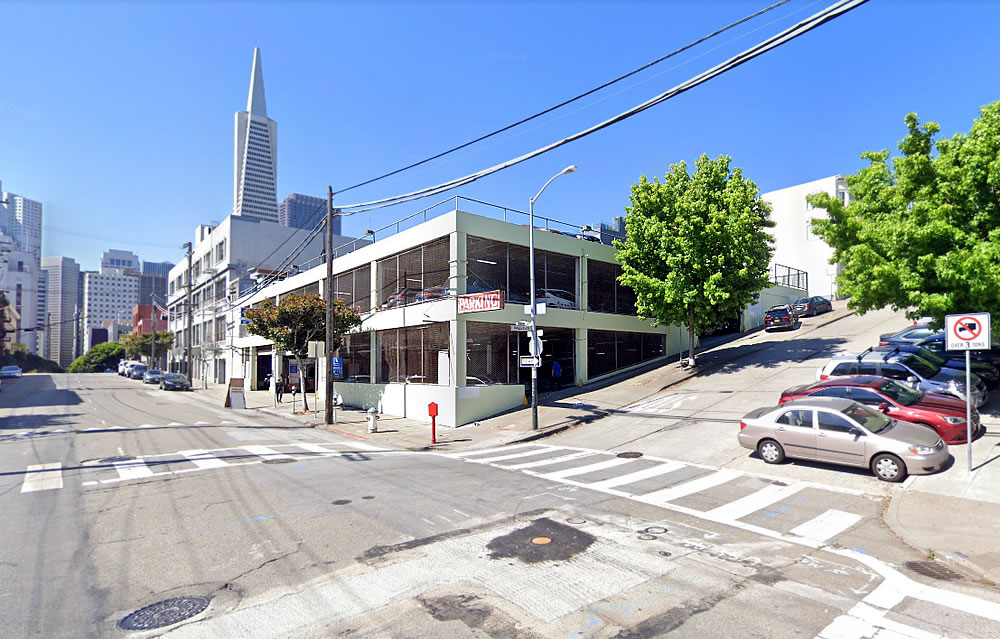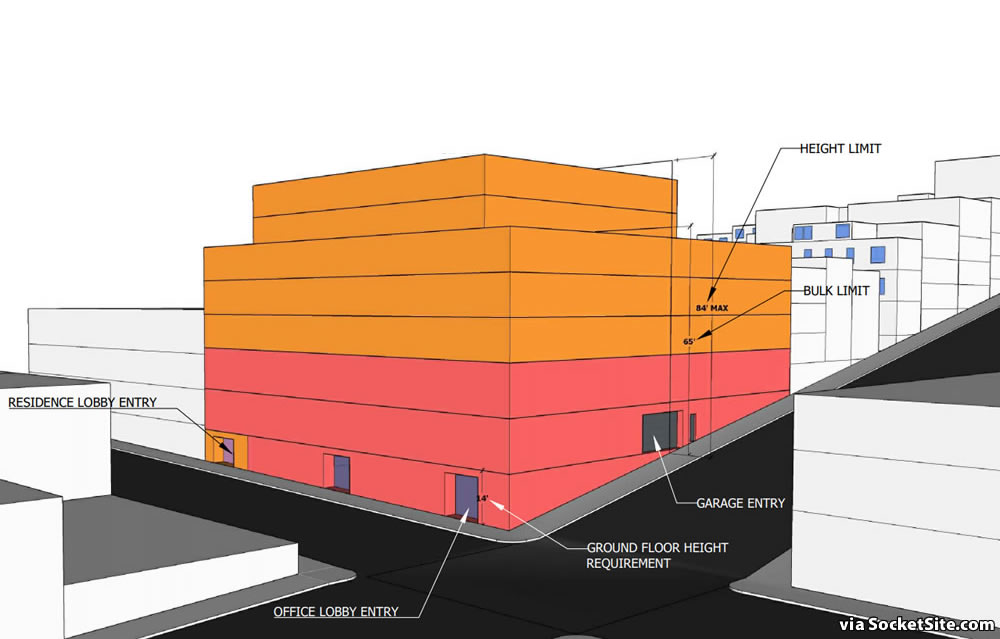As we revealed last month, plans to the redevelop the parking garage parcel at 955 Sansome Street, at the intersection of Vallejo, have been drawn. And as envisioned, a seven-story building with an additional “mezzanine” level would rise up to 84 feet in height on the lower Telegraph Hill site, with 24 market-rate condos over three floors (44,100 square feet) of office space and a garage for 46 cars with its entrance on Vallejo.
And while Planning’s preliminary review of the draft plans didn’t raise any major red flags, but did solicit a request to reduce the number of proposed parking spaces in the building’s garage, the Planning Department has received “multiple inquiries from individuals within the immediate neighborhood as well as community groups” which have raised “questions and concerns” as to the proposed development’s “height, impacts to light and air on adjacent sites, and the [proposed] office use,” along with the aforementioned number of proposed parking spaces.
In addition, while the proposed development wouldn’t cast any shadows on any publicly accessible open space(s), it would cast shadow on the John Yehall Chin Elementary School property. And while the school doesn’t currently participate in the Shared Schoolyard Program, a shadow analysis for the proposed development could be required, and raise a potential barrier to development, if the school’s schoolyard status should change prior to the project being approved.
We’ll keep you posted and plugged-in.


Telegraph hill dwellers association does not mess around, no matter the merits of their complaints.
The shadow-casting ordinance has to be one of the top-5 abused objections, especially here when school playgrounds are not covered under the ordinance. It’s a hypothetical objection, as though the voters in 1984 who passed proposition K might have accidentally overlooked a small school playground.
This plan seems fine, office and residential in a mixed use corridor, with a lot of offices on the same block, seems pretty ok to me.
Build it.
Why do we need a tower at the base of telegraph hill when there are only 24 homes being built, and the only reason they are seeking height is for 3K per square ft luxury condos? Why is office space on the table at all given that the city is changing and offices aren’t really necessary?
a “tower”, LOL
Classic incoherent “just asking questions” babble from the NIMBYs.
Remember, there is always a reason to block housing.
No one has a problem with building 24 units of housing, even if it is luxury as it is in this case. However, adding the extra height to make the housing units higher than the surrounding buildings in order to maximize profit is at issue. Are you familiar with the neighborhood? Do you realize that offices are not needed in this spot? How about this to get a gauge on what you find appropriate – how would you feel about a building equal in height of Coit Tower next to Coit Tower? If yes, then we can end this exercise in paid YIMBY nonsense.
we definitely need it, and this is a great walkable place for it. 7 stories is a low rise, not even a midrise, much less a tower
“No one has a problem with building 24 units of housing”. The planning department and the board of supervisors do. They get less subsidized housing
This is a prime example of why state legislators have taken so many actions to weaken municipal governments ability to block projects from moving forward.
This is also a prime example of why the city’s application system is broken and need state government intervention. A PPA document is worthless and simply allows the city and neighbors time to organize and block a project from moving forward. The city requires projects to file a PPA application but it does not consider the PPA application to be a development application under state law.
According to this article, the city is using this lag time to amend local regulations to potentially block this project. It sounds like a land use attorney’s dream and another bad look for the san francisco.
Should the city have wanted to added John Yehall Chin Elementary School to the shared school yard program, they should have undertaken the legislative change when they were approving the multi-year/multi-million dollar renovation.
Also, this project could have proposed 100% residential with the addition of a 50% state density bonus in place of this modest proposal. Maybe they should dual track the entitlements and see which version the neighbors prefer???
I can’t wait to see San Francisco in a few decades when most of the legacy car-centric uses, including parking garages, surface lots, autobody shops, gas stations, oil change stations, etc have been replaced with nice mid-sized buildings like this.
San Francisco is already pretty great but is going to be a dream in a few decades with these infill projects and the accelerating anti-car, pro-bike, pro-micromobility, pro-Slow Streets movement.
Hey I felt the same way 25 years ago when I moved to SF! Transit first! Bikes! Bullet train! 2021 and it’s still choked with cars.
Point taken, but here’s why it’s different this time.
– The massive increase of protected bike lanes added in just two years, notably in SOMA
– Car-Free Market St (2020)
– Slow Streets (2021)
– Micromobility technology like ebikes and scooters (2018?)
– electric car uptake (30% CAGR)
– Emphasis on building more (See SS articles on number of units under construction / in pipeline)
– emphasis on less parking (see this article)
These are tangible changes. Cars will still have their place, but they are being squeezed right now in many directions.
Have you ridden Market St. recently? Calling it car-free is a grotesque joke. An SUV ran over 5 people on it just yesterday.
What percent have cars decreased? 50%? 80%? It’s somewhere in there. From a quick Google, bike ridership is up 25%, Scooters up, MUNI is faster.
Car – Free Market is a massive improvement. Now citizens are realizing how great Slow Streets are. The pace of “car free” streets being added is much faster
Back in reality, a literal city supervisor is referring to the closure of a single digit percent of Golden Gate Park’s roadways to cars as “recreational redlining.” It’s an uphill battle, not a snowballing change in sentiment.
I agree. I moved to SF in 1991 ( since moved away ). Muni underground was for lack of a better term a Train Wreck, still is. Homelessness and open drug use everywhere, still the same. Bike messengers and bike culture fighting for a bicycle friendlier city have made little headway. Garbage, filth, vomit, urine. Still, still, still, still.
Agreed. I’m all for reducing dependency on cars, but come on, the city and Bay Area have yet to provide a reliable alternative. Bikes are great for the small percentage who use them and they deserve dedicated bike lanes. Meanwhile, transit improvements remain unseen and the obscene cost of living has forced many folks to reside in exurbia which, by coincidence, requires a car.
Young panhandler, ’tis folloy, hubris even, to predict the future 30 years on.
Hard to be objective when that prediction is laden with ones own agendas/dreams, so clearly on display here.
(I’ve nothing against slow, quieter streets, but I won’t be celebrating the death of self-contained, weatherproof, motor-propelled personal transport vehicles in my lifetime. Sorry.)
Haha, fair. FWIW, I don’t completely hate cars, either. We just need them smaller, quieter, slower and less polluting. Think electric Smart cars with a 20 MPH Max in SF
The mistake you and the other urbanist champions keep making is that you assume that making parking more difficult is going to reduce cars on the street and induce people to ride bikes and public transit instead. Dara Khosrowshahi is actively working against you, and he’s willing to lose billions of dollars per year to thwart your wishes.
It’s going to be close to impossible to realize any of these four desires unless the state somehow figures out how to get rid of Uber, Lyft and the other services like them. Which, given what happened with Prop 22, seems equally impossible.
I agree with you that Uber/Lyft are here to stay. Public transportation is screwed because Uber/Lyft is just better – faster, cleaner, safer, more convenient. Notice that I never said anything in favor of public transport.
Uber/Lyft can exist/thrive and you can still have a San Francisco without parking garages, surface lots, gas stations, autobody shops, oil change stations, etc because those cars will be driving in from outside of SF, as they already are.
Uber/Lyft can co-exist with Slow Streets and reduced lanes, too.
Vaguely fond memories of parking my whale of a 1963 Mercedes there in 1991-1992 while consulting on the restoration of the Legion of Honor Museum. I think I paid a whopping $2.75 for the early bird all day special.
So the copy here says 84’ but the illustration shows that as the max limit and the building exceeding 84’ by quite a bit… or am I missing something, like the illustration is missing any indication of what the bldg would actually look like…
I’m excited to see this built. I’d also be happy with an alternative that was taller with more housing and more BMR (but I understand shade studies and parking might make that infeasible under the current rules).
Proof once again that a building can be designed to embody morbid obesity.
UPDATE: Proposed Telegraph Hill Infill Project Has Been Supersized as Well